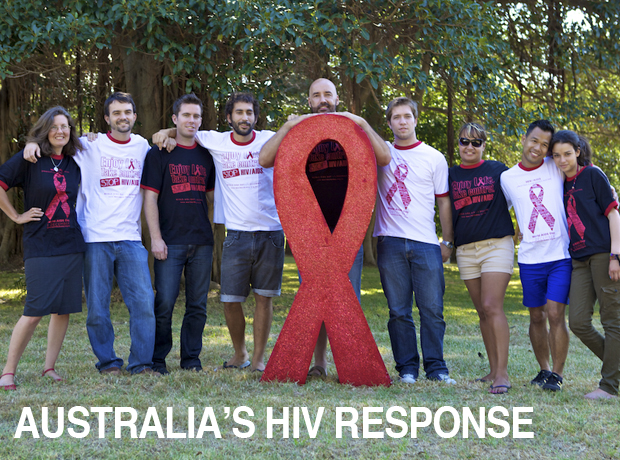HIV Media Guide
Information for journalists
HIV statistics in Australia
This snapshot of the latest HIV data for Australia is drawn from the Kirby Institute’s 2016 Annual Surveillance Report (for the year ending 31 December 2015):
- At the end of 2015, an estimated 25,313 people were living with HIV in Australia, of whom an estimated 2,619 (10%) were unaware of their HIV-positive status. In Australia, HIV transmission continues to occur primarily through sexual contact between men.
- In 2015, 1,025 people were diagnosed with HIV. The number of newly diagnosed HIV infections in Australia has remained stable for the past three years, with 1,025 cases in 2015, 1,082 in 2014, 1030 in 2013 and 1,064 in 2012.
- Over a quarter (29%) of new HIV diagnoses in Australia in 2015 were diagnosed late, emphasing the ongoing importance of regular HIV testing.
- By 31 December 2015, 36,171 cases of HIV had been diagnosed in Australia since the first diagnoses in 1982.
- The annual number of AIDS diagnoses in Australia peaked at 953 cases in 1994. After 1994, AIDS diagnoses declined rapidly due to the introduction of effective antiretroviral therapies which delay progression from HIV to AIDS and few people are now diagnosed with AIDS.
Of all HIV diagnoses made in Australia in 2015:
- 68% of transmissions occurred among men who have sex with men
- 5% of transmissions were attributed to either male-to-male sex or injecting drug use
- 20% of transmissions were attributed to heterosexual sex, and
- 3% of transmissions were attributed to injecting drug use
- for 4% of transmissions, the mode of transmission was undetermined.
Treatments access:
Of the estimated 22,694 (90%) people with HIV in Australia who were aware of their HIV-positive status at end of 2015, an estimated 19,051 (84%) were receiving antiretroviral (ARV) treatment. 92% of people accessing ARV treatment were estimated to have an undetectable viral load.
These figures compare well to the UN '90-90-90' targets - i.e., that by 2020, 90% of people living with HIV know their status, 90% of people diagnosed with HIV are on treatment, and 90% of people on treatment have suppressed viral loads.
Aboriginal and Torres Strait Islander people:
- Among the total of 1,025 notifications of newly diagnosed HIV infection reported in 2015, 38 were identified as Aboriginal and Torres Strait Islander.
- Between 2013 - 2015, the notification rate of newly diagnosed HIV infection was higher for the Aboriginal and Torres Strait Islander population compared to the non-Indigenous Australian-born population (6.8 vs. 5.9 per 100 000 in 2015).
- The notification rates of newly diagnosed HIV infection in the Aboriginal and Torres Strait Islander population are based on small numbers, and may reflect localised occurrences rather than national patterns.
- In the five-year period 2011 - 2015, a higher proportion of notifications of newly diagnosed HIV infection among the Aboriginal and Torres Strait Islander population were attributed to injecting drug use (16% vs. 3%) and heterosexual sex (21% vs. 14%) .
- Based on tests for immune function, in 2015 a third (30%) of the new HIV diagnoses among the Aboriginal and Torres Strait Islander population were determined to be late, in that they were in people who were likely to have had the infection for at least 4 years without being tested.
The higher rate of HIV diagnosis in Aboriginal and Torres Strait Islander peoples in the past five years requires a strengthened focus on prevention in this vulnerable population.
People from high HIV prevalence countries:
- In addition to the 1,025 newly diagnosed cases of HIV in 2015, there were 218 HIV cases previously diagnosed overseas with a confirmatory test conducted in Australia.
- Around 25% of all diagnoses between 2009 and 2013 (more recent data not available) were among people born in countries with high rates of HIV. A large proportion of these diagnoses were among heterosexuals.
- Among 201 cases of HIV diagnosed in 2014 and attributed to heterosexual sex, 36% were in people born in countries recognised by UNAIDS as having a national HIV prevalence above 1%, and 16% were in people with sexual partners who were born in these countries.
AIDS diagnoses:
- The annual number of AIDS diagnoses in Australia peaked in 1994, at 953 cases. AIDS diagnoses then declined rapidly following the introduction of effective combination antiretroviral therapy.
- There are now few people diagnosed with AIDS in Australia and it is no longer a notifiable disease (i.e. required by law to be reported to the Health Department).





